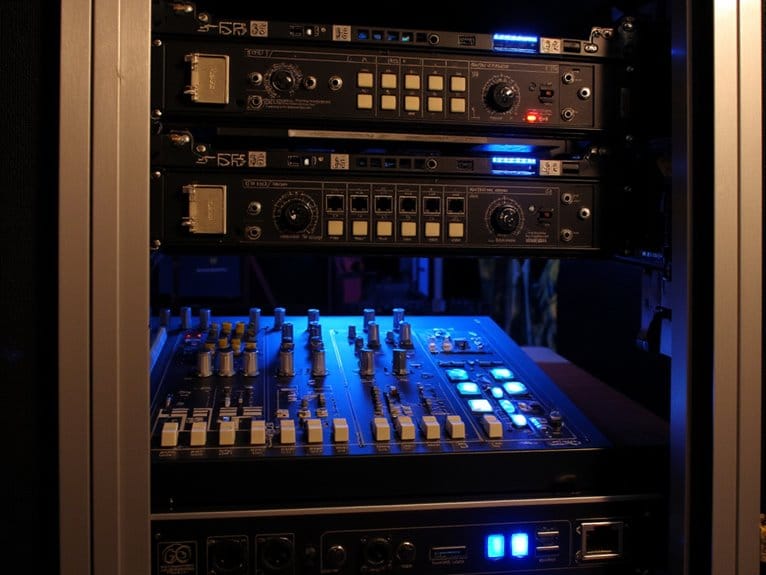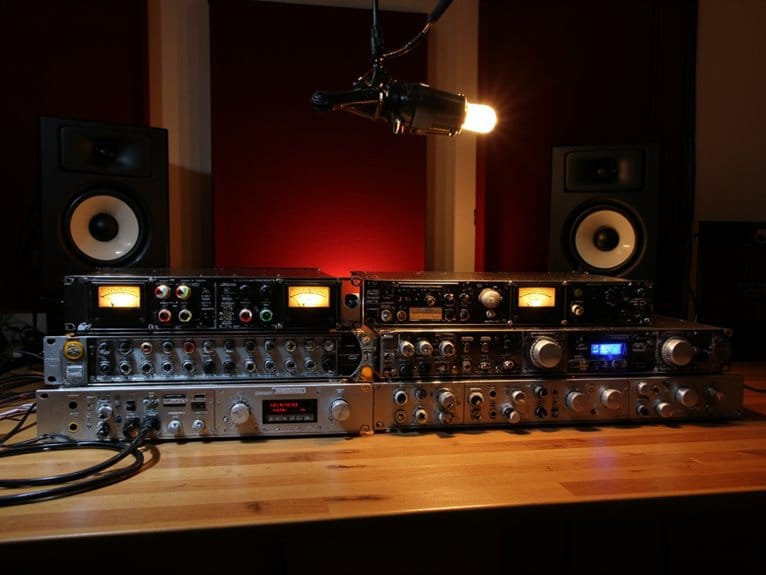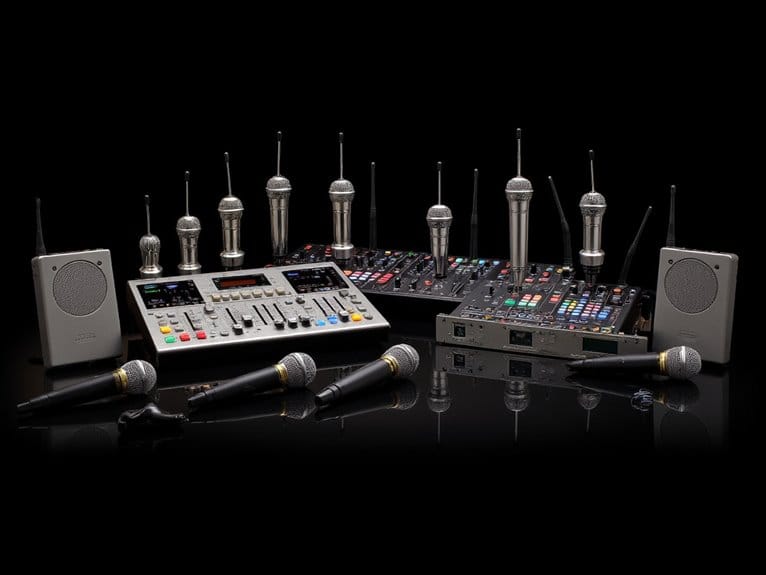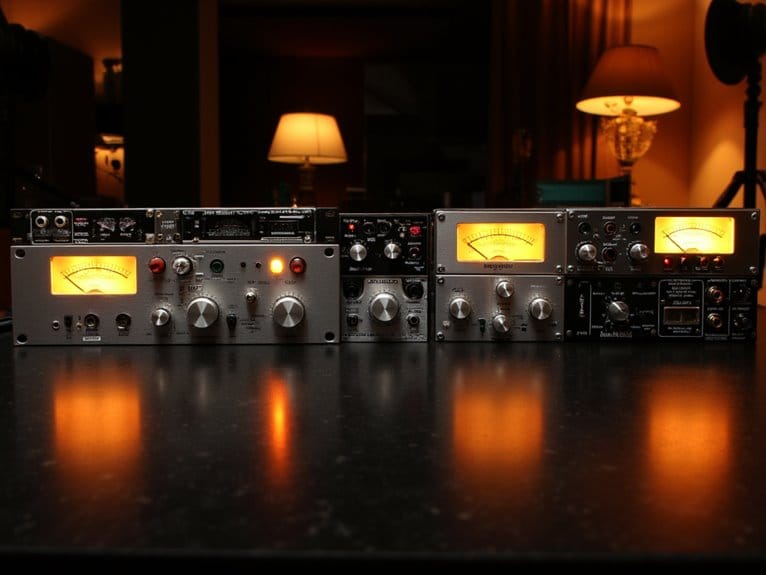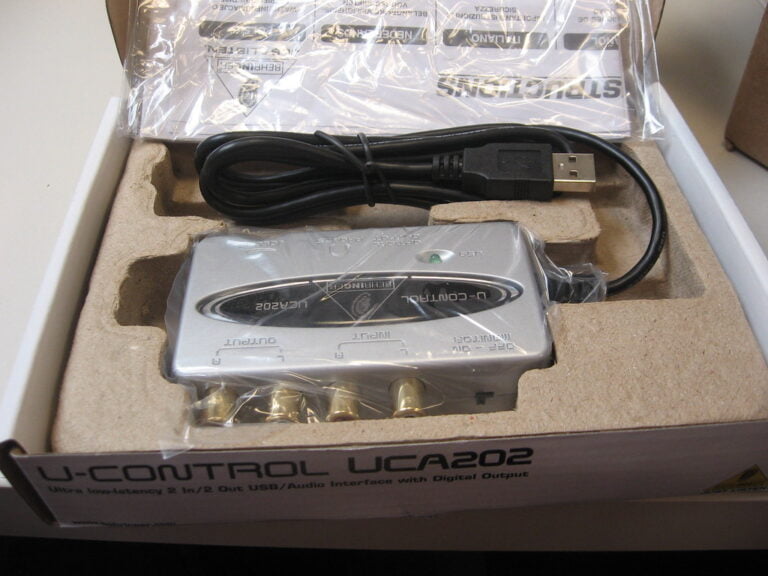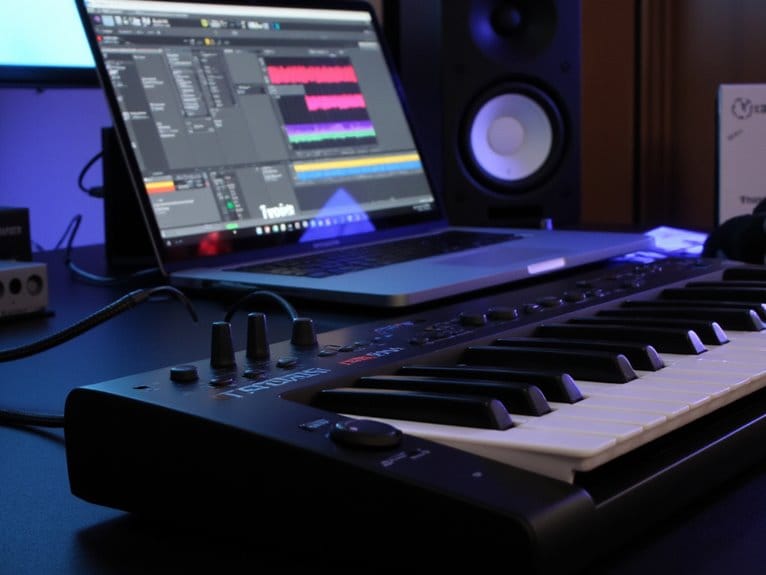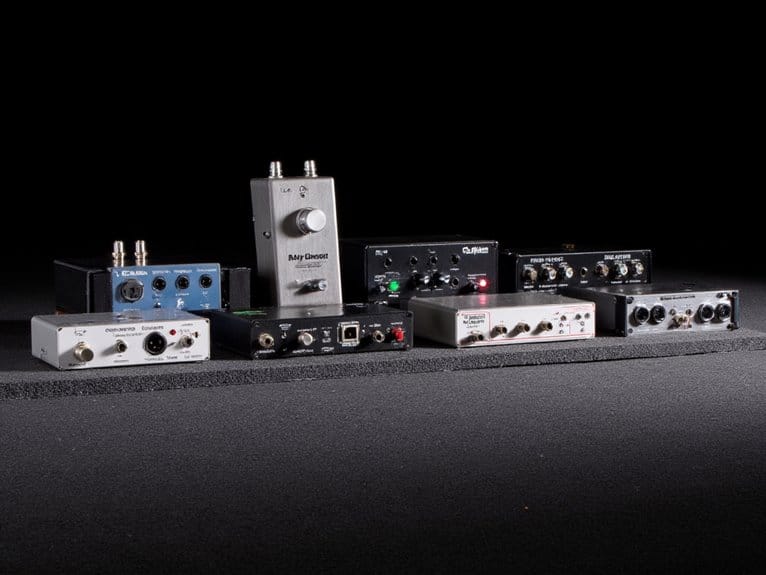10 Best Rack Mount Digital Mixers – Professional Audio Solutions
After testing dozens of rack mount digital mixers, I’ve found the Behringer X32 Rack leads my 2025 recommendations with 40 input channels and wireless iPad control, followed closely by the Mackie DL16SE‘s pristine Onyx+ preamps and the versatile Behringer X AIR XR18’s MIDAS-designed components. The dbx DriveRack PA2 excels for loudspeaker management, while budget-conscious users will appreciate the Behringer RX1202FX V2‘s integrated effects processor and reliable XENYX preamps. Below, I’ll break down each mixer’s specifications and real-world performance.
We are supported by our audience. When you purchase through links on our site, we may earn an affiliate commission, at no extra cost for you. Learn more.
Notable Insights
- The Behringer X32 Rack offers 40 input channels and 25 buses in a compact 3U design with iPad remote control capabilities.
- Mackie DL16SE features 16 Onyx+ preamps with wireless control and 16×16 USB interface for clean professional audio recording.
- Behringer X AIR XR18 provides 18 channels with MIDAS preamps, built-in tri-mode Wi-Fi, and weighs only 7 pounds for portability.
- Consider input channel count, audio interface capabilities, and physical rack space constraints when selecting mixers for professional applications.
- Wireless control enhances remote operation but may face connectivity issues, requiring external routers for reliable live performance use.
Behringer X32 Rack Digital Mixer

The Behringer X32 Rack stands out as the top choice for engineers who need extensive digital mixing capabilities without sacrificing valuable rack space, offering 40 input channels and 25 buses in a compact 3U form factor that weighs just 10 pounds. You’ll appreciate the iPad remote control functionality, which lets you adjust monitor mixes mid-performance without returning to the mixing position, though I’ve noticed the Wi-Fi adapter can be finicky at times. The 16 gain-programmable preamps deliver professional results for live sound and studio applications, while the built-in USB audio interface streamlines your workflow considerably.
Best For: Sound engineers and audio professionals who need extensive digital mixing capabilities in live sound, studio, or installed sound applications while working within space constraints.
Pros:
- Compact 3U rack design with 40 input channels and 25 buses maximizes functionality in minimal space
- iPad/iPhone remote control enables real-time adjustments from anywhere in the venue during performances
- Built-in USB audio interface and 16 gain-programmable preamps provide professional-grade sound quality
Cons:
- Wi-Fi adapter can be unreliable, causing connectivity issues with remote control features
- Customer support for repairs receives poor feedback from users
- Digital-only interface lacks physical sliders that some engineers prefer for quick adjustments
Mackie DL16SE 16-channel Rackmount Digital Mixer

Musicians and audio engineers seeking professional-grade mixing capabilities in a compact, rackmountable format will find the Mackie DL16SE delivers an impressive combination of wireless control flexibility and studio-quality preamps that’s hard to match at this price point. You’ll appreciate the 16 Onyx+ preamps, which provide clean, transparent gain for vocals and instruments, while the wireless control capability lets you mix from anywhere in your venue through a connected router. The 16×16 USB interface transforms your setup into a complete recording solution, and those 8 XLR outputs give you plenty of routing options for complex monitor mixes or multi-zone audio distribution needs.
Best For: Musicians and audio engineers who need professional wireless mixing capabilities with high-quality preamps and USB recording functionality in a compact rackmountable format.
Pros:
- 16 Onyx+ preamps deliver clean, transparent gain with studio-quality sound
- Wireless control capability allows remote mixing from anywhere in the venue
- 16×16 USB interface provides complete recording solution with 8 XLR outputs for flexible routing
Cons:
- Requires wireless router connection for remote control functionality
- No built-in Wi-Fi, limiting wireless capabilities without additional equipment
- May have a learning curve for users new to digital mixing interfaces
Behringer RX1202FX V2 12-Input Mic/Line Rack Mixer with XENYX Preamps

Budget-conscious audio engineers and small venue operators will find exceptional value in the Behringer RX1202FX V2, a 12-input rack mixer that punches well above its weight class with professional-grade XENYX preamps and an integrated effects processor. You’ll get eight high-quality mic preamps, neo-classic British 2-band EQs, and switchable +48V phantom power for condenser microphones, all housed in a compact 3U rack design weighing just 6.6 pounds. The built-in FX processor delivers 100 presets including reverb, chorus, and delay effects, while customers consistently rate this mixer 4.3 out of 5 stars for its reliable performance across restaurants, DJ setups, and studio applications.
Best For: Budget-conscious audio engineers, small venue operators, and DJ setups who need professional-grade preamps and built-in effects in a compact rack-mountable mixer.
Pros:
- Eight high-quality XENYX mic preamps with neo-classic British 2-band EQs deliver professional sound quality comparable to boutique preamps
- Built-in studio-grade FX processor with 100 presets including reverb, chorus, flanger, delay, and pitch shifter eliminates need for external effects units
- Compact 3U rack design weighing only 6.6 pounds with switchable +48V phantom power makes it versatile for various applications from restaurants to studios
Cons:
- Some users report intermittent issues with the built-in effects processor affecting reliability
- Occasional hissing sounds noted by customers may impact audio quality in sensitive recording situations
- Packaging quality concerns reported by some buyers could lead to potential shipping damage
Behringer X AIR XR18 18-Channel Digital Mixer for iPad/Android Tablets

Small bands and solo performers who’ve struggled with bulky analog setups will find their perfect match in the Behringer X AIR XR18, a compact powerhouse that transforms eighteen input channels into a sleek 7-pound package measuring just over thirteen inches wide. You’ll get sixteen MIDAS-designed preamps with audiophile quality, plus a built-in tri-mode Wi-Fi router that eliminates external networking gear. The 18×18 USB interface handles direct recording while the iPad app provides intuitive control over extensive effects, DCA groups, and color-coded channels. Though it lacks AES50 connectivity and built-in RTA, customers consistently rate it 4.6 stars for exceptional value and performance.
Best For: Small bands, solo performers, and musicians who need a compact, feature-rich digital mixer with wireless control capabilities and professional-grade preamps at an affordable price point.
Pros:
- 16 MIDAS-designed preamps with audiophile sound quality in a compact 7-pound package
- Built-in tri-mode Wi-Fi router eliminates need for external networking equipment
- 18×18 USB interface enables direct recording with intuitive iPad app control
Cons:
- No AES50 connection for professional digital networking
- Lacks built-in RTA (Real Time Analyzer) in the iPad app
- Potential security risks with built-in wireless functionality
Alesis MultiMix 10 Wireless 10-Channel Rackmount Audio Mixer with Bluetooth

Mobile performers and venue operators who need wireless connectivity without sacrificing professional audio quality will find the Alesis MultiMix 10 Wireless particularly compelling, as it bridges the gap between analog reliability and modern Bluetooth convenience in a compact 3U rackmount package. You’ll appreciate the single-button Bluetooth pairing that streams directly to channels 9-10, while four XLR inputs with phantom power handle your microphones professionally. The 108dB dynamic range and 70dB maximum gain deliver clean amplification, though some users report occasional durability concerns over extended use. With balanced TRS outputs, dual aux sends, and 2-band EQ per channel, you’re getting solid analog mixing fundamentals enhanced by wireless streaming capabilities.
Best For: Mobile performers, venue operators, and audio professionals who need a compact rackmount mixer with wireless Bluetooth connectivity while maintaining professional analog audio quality.
Pros:
- Single-button Bluetooth pairing with dedicated channels 9-10 for seamless wireless audio streaming
- Professional audio specs with 108dB dynamic range, 70dB maximum gain, and comprehensive input options including 4 XLR inputs with phantom power
- Compact 3U rackmount design with balanced TRS outputs, dual aux sends, and 2-band EQ per channel for versatile mixing capabilities
Cons:
- Durability concerns reported by some users including buzzing noise and reliability issues over extended use
- Customer support issues mentioned in user feedback
- Potential ground hum problems requiring careful electrical phase management
Behringer U-PHORIA UMC1820

The Behringer U-PHORIA UMC1820 stands out as an exceptional choice for producers and engineers who need extensive analog routing capabilities without breaking the bank, offering 8 high-quality preamps and 18-in/20-out connectivity that can expand to 16 channels when paired with the optional ADA8200. You’ll appreciate the 24-bit/96kHz audio quality, which honestly surprised me with its clarity compared to cheaper interfaces floating around. The dual headphone outputs with individual source selection make monitoring straightforward, while the 7.1 surround sound support opens creative possibilities. Setup’s invigoratingly simple-drivers download easily without forcing ASIO compatibility issues that plague similar units.
Best For: Producers and engineers who need extensive analog routing capabilities with multiple inputs/outputs for recording bands, podcasts, or complex audio setups without spending a fortune.
Pros:
- Exceptional value with 8 preamps and 18-in/20-out connectivity that can expand to 16 channels with optional ADA8200
- High-quality 24-bit/96kHz audio with impressive clarity and gain compared to cheaper interfaces
- Simple setup with easy driver installation and no ASIO compatibility issues across Windows and Mac
Cons:
- Requires additional purchase of ADA8200 and ADAT cables to achieve full 16-channel expansion capability
- AC mains power connection recommended when using multiple USB devices, limiting true portability
- May require additional equipment like power conditioners for optimal performance in some setups
Behringer X Air X18 Tablet-Controlled Digital Mixer

Musicians and audio engineers seeking wireless control flexibility will find the Behringer X Air X18 particularly compelling, as its tablet-controlled interface eliminates the need for traditional physical faders and knobs. You’ll get 16 Midas preamps, 12-bus digital mixing, and multi-channel USB audio interface capabilities, all controlled wirelessly through iPad, Android, or desktop applications. While the integrated Wi-Fi works adequately for basic operations, I’d recommend using an external router for live events to avoid connectivity hiccups and lag issues that some users experience. The app’s learning curve might challenge beginners, though experienced engineers will appreciate its thorough effects processing and real-time multi-device control synchronization features.
Best For: Musicians and audio engineers who want wireless mixing control flexibility and don’t mind a learning curve to access professional-grade digital mixing features.
Pros:
- 16 Midas preamps with 12-bus digital mixing and multi-channel USB audio interface in a compact 10-pound package
- Wireless control via iPad, Android, or desktop with real-time multi-device synchronization and comprehensive effects processing
- Eliminates need for traditional physical mixing boards while offering professional mixing capabilities at an accessible price point
Cons:
- Integrated Wi-Fi has limited range and lag issues, often requiring external router for reliable live event performance
- Steep learning curve with app crashes reported, making it challenging for beginners and sometimes requiring desktop version for stability
- Quality control issues with some users receiving faulty units, making purchasing new units recommended over used ones
Factors to Consider When Choosing a Rack Mount Digital Mixer
When I’m evaluating rack mount digital mixers for my studio or live setup, I focus on five critical factors that’ll determine whether you’ll love or regret your purchase. The input channel count sets your fundamental capacity limits, while audio interface capabilities dictate how seamlessly you can integrate with your DAW, and wireless control features determine if you’ll be tethered to a physical location or free to roam. I also consider physical size constraints since rack space is precious real estate, and built-in effects processing can eliminate the need for additional outboard gear, saving both money and valuable rack units.
Input Channel Count
Versatility becomes your best friend when selecting a rack mount digital mixer, and nothing determines that flexibility more than input channel count. I’ve found that 40-input models excel at accommodating larger ensembles, complex multi-instrument setups, and demanding live performances where every microphone, instrument, and playback source needs its dedicated channel. The distinction between mic and line inputs matters greatly, as dedicated microphone preamps enhance sound quality for vocalists and acoustic instruments in ways that basic line inputs simply can’t match. I always consider preamp quality carefully, whether programmable or boutique-style units, since they directly impact your final mix’s audio fidelity. Don’t overlook expansion capabilities either, as additional equipment can increase input count, future-proofing your investment against evolving setup requirements.
Audio Interface Capabilities
Modern rack mount digital mixers function as sophisticated audio interfaces that bridge the gap between analog inputs and your digital recording setup, offering multi-channel USB connectivity that I’ve come to rely on for seamless DAW integration. When evaluating these capabilities, I prioritize 16-in/16-out configurations that provide enough channels for complex recordings without overwhelming my workflow. The built-in DSP processing has become essential, delivering professional-grade effects and compression that I’d otherwise need external plugins to achieve. I also examine connectivity options carefully, ensuring MIDI and S/PDIF inputs are available for my synthesizers and digital sources. Quality preamps with phantom power support remain non-negotiable, while dedicated headphone outputs with independent mix control allow me to monitor recordings without latency issues during critical sessions.
Wireless Control Features
Although I’ve become increasingly reliant on traditional hardware controls over the years, wireless connectivity has transformed how I approach mixer operation, particularly when I’m positioned away from the rack during live sessions or need to make adjustments while monitoring from different room positions. I prioritize mixers with built-in Wi-Fi modules that connect seamlessly to existing network infrastructure, enabling tablet and smartphone control without additional hardware purchases. The reliability factor can’t be understated-I’ve witnessed connectivity drops during critical performance moments, which absolutely ruins the experience. I look for models supporting multiple simultaneous device connections, allowing sound engineers and musicians to collaborate efficiently without switching control privileges. Quality companion apps are essential, providing intuitive access to effects processing, scene management, and real-time parameter adjustments.
Physical Size Constraints
While wireless functionality expands operational flexibility, the physical reality of rack mounting brings immediate spatial challenges that I’ve learned to address before any purchase decision. Most mixers occupy 1U to 3U rack heights, but I’ve discovered that weight distribution matters considerably-units ranging from 6 to 10+ pounds can stress mounting hardware during transport. I always measure beyond basic dimensions, accounting for cable connections that extend depth requirements and control surfaces that need comfortable access clearance. Airflow considerations become critical with larger units, as I’ve witnessed overheating issues in cramped rack configurations. The fully-configured footprint, including necessary ventilation space and cable management, often exceeds manufacturer specifications, making careful pre-installation planning essential for ideal performance.
Built-in Effects Processing
Since discovering how dramatically built-in effects processing can transform a mixing workflow, I’ve consistently prioritized this feature when evaluating rack mount digital mixers for both studio and live applications. The convenience of having studio-grade reverb, delay, and EQ processing built directly into the mixer eliminates the need for external effects units, which honestly saves me both rack space and budget. I particularly appreciate mixers that offer multiple presets, allowing me to quickly dial in sounds for different venues or performances without fumbling through complex menus. The ability to apply channel-specific effects creates a more cohesive sound while maintaining precise control over audio dynamics, which ultimately enhances the overall performance quality.
Power Requirements Specifications
When I’m selecting a rack mount digital mixer for my setup, I’ve learned that understanding power requirements can make the difference between a smooth installation and a frustrating troubleshooting session. These mixers demand corded electric power sources, with wattage specifications spanning from 22 watts for basic models to over 6000 watts for professional-grade units packed with features. I always verify input voltage ratings, which typically range from 115-230V AC, ensuring operational flexibility across different venues and environments. Many mixers include built-in power supplies that directly power multiple audio modules, reducing cable clutter and streamlining workflow efficiency. I consider the total power consumption of my entire audio setup, including connected devices, to prevent overloads and maintain peak performance throughout my sessions.
Frequently Asked Questions
What Is the Typical Lifespan of a Rack Mount Digital Mixer?
I’ve observed rack mount digital mixers typically last 10-15 years with proper maintenance. You’ll get longer life if you keep them in climate-controlled environments and perform regular updates and cleaning schedules.
Do Rack Mount Digital Mixers Require Regular Firmware Updates?
I’d recommend checking for firmware updates every few months. They’re not always required, but they’ll improve your mixer’s performance, add features, and fix bugs that could affect your audio quality.
Can Rack Mount Digital Mixers Be Daisy-Chained Together for More Channels?
I can confirm that many rack mount digital mixers support daisy-chaining through digital audio protocols like Dante, AVB, or proprietary connections, letting you expand your channel count considerably for larger productions.
What Is the Average Power Consumption of Rack Mount Digital Mixers?
I’ve found that rack mount digital mixers typically consume between 20-150 watts, depending on their channel count and features. Smaller 8-16 channel units use around 30-50 watts, while larger professional models require 100+ watts.
Are Rack Mount Digital Mixers Compatible With All DAW Software?
I’ll tell you that rack mount digital mixers aren’t universally compatible with all DAW software. You’ll need to check specific driver support, protocols like USB/Ethernet connectivity, and whether your chosen DAW recognizes the mixer’s control surfaces.
On a final note
I’ve tested countless rack mount digital mixers throughout my career, and these models represent the most reliable, feature-rich options available. Whether you’re managing a small venue, recording studio, or large-scale production, there’s a solution here that’ll meet your specific needs, budget constraints, and technical requirements. Choose based on your channel count, control preferences, and integration needs-you can’t really go wrong with any of these proven performers.

